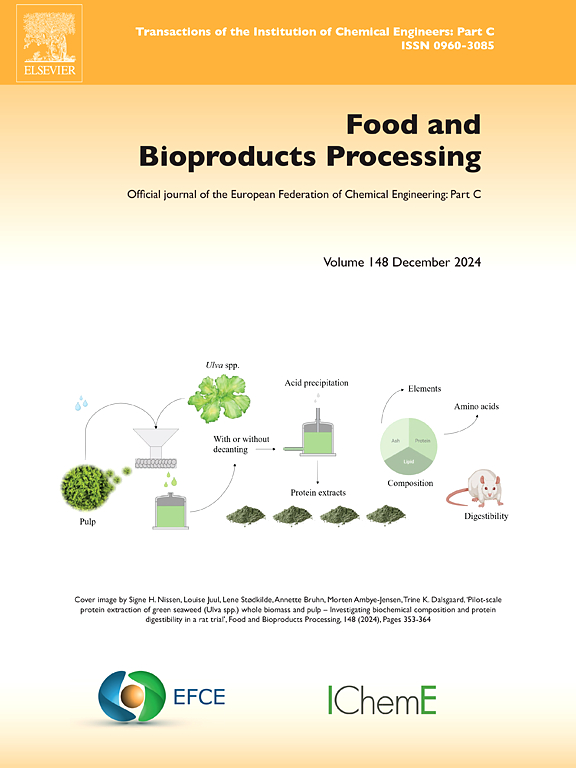3D modeling and optimization of batch sterilization for irregularly shaped spicy chicken retort pouches
IF 3.4
2区 农林科学
Q2 BIOTECHNOLOGY & APPLIED MICROBIOLOGY
引用次数: 0
Abstract
Sterilization is essential for achieving the safety, shelf life, and quality of spicy chicken retort pouches (SCRPs). However, the irregular and geometrically complex shapes of chicken pieces lead to variable cold spot locations, complicating optimization of batch sterilization. To address this challenge, a 3D simulation-based approach was adopted to develop a transient heat transfer model for irregularly shaped SCRPs, and a novel geometry-control method was introduced to standardize product shape, enabling the construction of a corresponding model for regularly shaped SCRPs. Both models were validated, showing high accuracy with coefficients of determination (R² > 0.981) and low mean relative errors (σ < 2.997 %) between experimental and simulated temperature profiles. The regularly shaped SCRP model was then applied to process optimization, identifying an optimal thickness of 20 mm and a variable retort temperature (VRT) profile of 95℃ for 25 min followed by 121℃ for 15 min. This schedule achieved an F value of 6.58, reduced the surface cook value (Cs) and the volume-average cook value (Cavg) by 42.95 % and 42.05 %, respectively, and shortened sterilization time by 26.07 %. Furthermore, the optimized process improved product quality by lowering shear force, moisture loss, and oil viscosity, while enhancing color retention and sensory acceptance. These findings confirm the reliability of the developed models and their potential to guide industrial batch sterilization design.
不规则形状麻辣鸡蒸煮袋分批灭菌的三维建模与优化
灭菌是实现麻辣鸡蒸煮袋(SCRPs)的安全性,保质期和质量的必要条件。然而,鸡块形状不规则且几何形状复杂,导致冷点位置多变,使批量灭菌的优化变得复杂。为了解决这一挑战,采用基于3D仿真的方法建立了不规则形状的SCRPs的瞬态传热模型,并引入了一种新的几何控制方法来标准化产品形状,从而能够构建规则形状的SCRPs的相应模型。两种模型均具有较高的精度,实验温度曲线与模拟温度曲线的决定系数(R²> 0.981)和较低的平均相对误差(σ < 2.997 %)。然后将规则形SCRP模型应用于工艺优化,确定了最佳厚度为20 mm,变温度(VRT)为95℃,25 min, 121℃,15 min。F值为6.58,表面蒸煮值Cs和体积平均蒸煮值Cavg分别降低了42.95 %和42.05 %,灭菌时间缩短了26.07 %。此外,优化后的工艺通过降低剪切力、水分损失和油粘度提高了产品质量,同时提高了保色性和感官接受度。这些发现证实了所开发模型的可靠性及其指导工业批量灭菌设计的潜力。
本文章由计算机程序翻译,如有差异,请以英文原文为准。
求助全文
约1分钟内获得全文
求助全文
来源期刊

Food and Bioproducts Processing
工程技术-工程:化工
CiteScore
9.70
自引率
4.30%
发文量
115
审稿时长
24 days
期刊介绍:
Official Journal of the European Federation of Chemical Engineering:
Part C
FBP aims to be the principal international journal for publication of high quality, original papers in the branches of engineering and science dedicated to the safe processing of biological products. It is the only journal to exploit the synergy between biotechnology, bioprocessing and food engineering.
Papers showing how research results can be used in engineering design, and accounts of experimental or theoretical research work bringing new perspectives to established principles, highlighting unsolved problems or indicating directions for future research, are particularly welcome. Contributions that deal with new developments in equipment or processes and that can be given quantitative expression are encouraged. The journal is especially interested in papers that extend the boundaries of food and bioproducts processing.
The journal has a strong emphasis on the interface between engineering and food or bioproducts. Papers that are not likely to be published are those:
• Primarily concerned with food formulation
• That use experimental design techniques to obtain response surfaces but gain little insight from them
• That are empirical and ignore established mechanistic models, e.g., empirical drying curves
• That are primarily concerned about sensory evaluation and colour
• Concern the extraction, encapsulation and/or antioxidant activity of a specific biological material without providing insight that could be applied to a similar but different material,
• Containing only chemical analyses of biological materials.
 求助内容:
求助内容: 应助结果提醒方式:
应助结果提醒方式:


